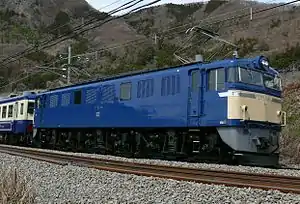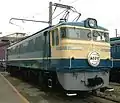| Class EF60 | |||||||||||||||||||||||
|---|---|---|---|---|---|---|---|---|---|---|---|---|---|---|---|---|---|---|---|---|---|---|---|
 Sole operational EF60 (EF60 19) on an excursion working, March 2008 | |||||||||||||||||||||||
| |||||||||||||||||||||||
| |||||||||||||||||||||||
| |||||||||||||||||||||||
| |||||||||||||||||||||||
The Class EF60 (EF60形) was the first Japanese second-generation DC electric locomotive type with six driven axles (classes EF60 to EF67), and the first versions used the same MT49 390 kW traction motors as the ED60 and ED61 designs. A total of 143 locomotives were built between 1960 and 1964 by Kawasaki, Tōshiba, Tōyō & Kisha Seizō, and Mitsubishi. The class was split between 129 freight locomotives (classified EF60-0) designed to supersede the mammoth EH10s on Tōkaidō and Sanyō Main Line freight, and 14 passenger locomotives (EF60-500) to replace EF58s on sleeping car trains on the Tōkaidō and Sanyō Mainlines.
The third-batch build of locos (EF60 84 to 129 and EF60 512 to 514) had up-rated traction motors and differed slightly in having twin headlamps (like the EF65 and other later types) rather than the single large headlamp on earlier versions. Unlike the ED60s, these locos were designed to operate singly rather than in pairs, and so cab-end gangway doors were not included. The EF60-0s initially appeared in the standard all-over brown livery, but were repainted into blue from 1965 onward.
The role of the EF60-500s at the head of the premier Blue Trains was short-lived, however, with the arrival of more powerful EF65s in 1965, and they too found themselves transferred to freight duties. From the late 1970s, EF60s were to be seen on the Chūō, Takasaki, and Ryōmō Lines in the Kantō region, and some locos were transferred to the Hanwa Line and Kisei Mainline in the Kansai region from the mid-1980s.
Withdrawals commenced in the 1980s, and all members of the class were withdrawn from regular operations in 1986, ahead of privatization. Two locos survived into JR days: EF60 19 owned by JR East for special event use, and EF60 503 by JR West. Eight early-built locos were converted to EF61-200s between 1977 and 1979 for use as bankers on the steeply-graded "Senohachi" section of the Sanyō Mainline between Seno and Hachihonmatsu. Three more later-built EF60s were more extensively rebuilt in 1982 to become EF67 class banking locos (numbers EF67 1 to 3) for use on the same section.
Build details
| Numbers | Batch | Built | Details |
|---|---|---|---|
| 1-2 | Prototype | 1960 | Different bogie designs. 390 kW MT49 traction motors. |
| 3-14 | 1st | 1960- | Based on EF60 1 design. Built with quill drive. |
| 15-83 | 2nd | 1962–1964 | Nose-suspended traction motors (425 kW MT54). |
| 84-129 | 3rd | 1964- | Twin sealed-beam headlights. Bodyside louvres and windows similar to EF65. |
| 501-511 | 2nd | 1963–1964 | Delivered in tokkyū blue livery. |
| 512-514 | 3rd | 1964 | Twin sealed-beam headlights. Bodyside louvres and windows similar to EF65. |
Banker conversions
EF61-200 conversions
Eight Class EF60 locomotives were converted between 1977 and 1979 to become Class EF61-200 banking locomotives for use on the "Senohachi" section of the Sanyo Main Line.[1]
| Original number | Built | Later number | Rebuilt |
|---|---|---|---|
| EF60 1 | 22 January 1960 | EF61 201 | 25 November 1977 |
| EF60 3 | 27 July 1960 | EF61 203 | 27 June 1978 |
| EF60 4 | 10 August 1960 | EF61 204 | 23 June 1978 |
| EF60 6 | 13 September 1960 | EF61 206 | 22 February 1979 |
| EF60 7 | 28 September 1960 | EF61 207 | 27 February 1979 |
| EF60 9 | 13 July 1960 | EF61 209 | 6 February 1978 |
| EF60 10 | 30 July 1960 | EF61 210 | 1 December 1977 |
| EF60 11 | 20 August 1960 | EF61 211 | 10 February 1978 |
EF67 conversions
Three Class EF60 locomotives were converted between 1982 and 1986 to become Class EF67 banking locomotives for use on the "Senohachi" section of the Sanyo Main Line.[1]
| Original number | Built | Later number | Rebuilt |
|---|---|---|---|
| EF60 88 | 9 July 1964 | EF67 3 | 25 December 1986 |
| EF60 104 | 30 September 1964 | EF67 1 | 31 March 1982 |
| EF60 129 | 27 October 1964 | EF67 2 | 30 January 1984 |
Preserved examples
- EF60 19 Preserved at JR East's Takasaki Depot in operating condition (occasional mainline use), repainted in 2007 into standard blue/cream livery (previously special white livery with blue/red stripes)
- EF60 47 No. 2 cab section only, on display inside JR East's Ōmiya Works, brown livery
- EF60 123 Plinthed in front of Ashikaga Station (JR Ryōmō Line), standard blue livery
- EF60 501 Usui Pass Railway Heritage Park, Gunma, in tokkyū blue livery
- EF60 503 Formerly preserved at JR West's Miyahara Depot (cut up November 2008[2])
- EF60 510 Preserved at JR East's Ōmiya Works in tokkyū blue livery[3]
 EF60 19 in "American Train" livery in 1988
EF60 19 in "American Train" livery in 1988 EF60 19 in "Yasuragi" Joyful Train livery in September 2005
EF60 19 in "Yasuragi" Joyful Train livery in September 2005 Cab end of EF60 47 inside JR East Omiya Works in May 2008
Cab end of EF60 47 inside JR East Omiya Works in May 2008 Preserved EF60 123 in front of Ashikaga Station in June 2013
Preserved EF60 123 in front of Ashikaga Station in June 2013 EF60 501 at the Usui Pass Railway Heritage Park in August 2004
EF60 501 at the Usui Pass Railway Heritage Park in August 2004 Preserved EF60 510 at Omiya Works open day in October 2011
Preserved EF60 510 at Omiya Works open day in October 2011
See also
References
- 1 2 Seki, Takahiro (December 2012). "セノハチの後押し機関車" [Senohachi Banking locomotives]. Japan Railfan Magazine. Vol. 52, no. 620. Japan: Koyusha Co., Ltd. pp. 86–93.
- ↑ RM News: "EF60 503号機 遂に解体". Retrieved on 18 November 2008. (in Japanese) Archived September 13, 2011, at the Wayback Machine
- ↑ "EF60 510が再塗装される" [EF60 510 repainted]. Japan Railfan Magazine Online (in Japanese). Japan: Koyusha Co., Ltd. September 2011. Retrieved 9 September 2011.
- Inoue, Kōichi (1999). 国鉄機関車事典 [JNR Locomotive Encyclopedia]. Japan: Sankaido. ISBN 978-4-381-10338-3.
